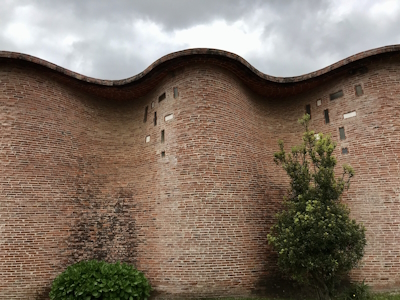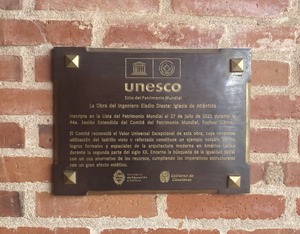Church of Atlántida

The work of engineer Eladio Dieste: Church of Atlántida is a parish church known for its innovative construction technique.
The brick structure’s lateral walls form a double curved shell. Reinforced ceramic, by putting steel bars in the joints of the bricks, was used. There is a separate bell tower and an underground circular baptistery. Eladio Dieste was a Uruguayan engineer who built a range of structures in Uruguay, Brazil, Argentina and Spain from the 1940s onward.
Community Perspective: “It is simple, yet impressive in its originality and spiritual atmosphere”. A visit will be a matter of minutes. The church is located in a working neighbourhood of Atlantida and generally only opens for Sunday services, but there is a “lady with a key” that can be called. Last reports (Dec 2023) suggest that opening hours are now 08:00-16.00 every day.
Map of Church of Atlántida
Community Reviews
Frédéric M

I visited the Iglesia Parroquia de Cristo Obrero y Nuestra Señora de Lourdes in Atlántida in March 2022. As described by previous reviewers, I took a bus from Montevideo going east and got off at the intersection for Atlántida. I then walked to the church. At first glance, from the outside, the church appears rather small and not necessarily impressive. Walking around it, one can see the brick exterior and the corrugated walls. The campanile is probably the most original structure visible from the outside, with its tiny steps winding up to the bells. When I arrived, the church was closed, and a couple of American tourists were also checking it out. They didn't know how to get in any more than I did.
This information is perhaps the most relevant in this review. The man running Kiosco 29 on the street corner east of the church, near the butcher shop, knew the lady with the church keys and was able to call her. So, after waiting a few minutes, a beautiful old lady arrived on her bicycle with her summer dress and the keys to the church. Another group of visitors had arrived in the meantime and were also enjoying the opening of the doors. The atmosphere in the church is really special. The curvature of the walls is still visible, but the curvature of the ceiling adds to the decor and creates an impressive effect. The average visitor will not be able to judge whether this construction is a feat of engineering, but he will recognize a unique building. The colored windows add an interesting touch to these walls. The unique atmosphere one feels is exacerbated by the fact that everything in the church is built of brick (from the confessionals to the balcony) and that the altar is particularly simple and austere.
Finally, the visit to this site takes only a few minutes, a little longer if you must work a little to find the key. It is difficult to assess how exceptional or influential this church is on the world heritage scale, but it provides a very pleasant visit and an original setting. It is possible to peek inside through a window in the door if the key is not available when you visit. I did not visit the baptistery.
Stanislaw Warwas

Visited November 2019.
The Church of Christ the Worker and Our Lady of Lourdes (Iglesia de Cristo Obrero y Nuestra Señora de Lourdes) is a Roman Catholic church located in Estación Atlántida, around 50 km east from central Montevideo. Most buses from Montevideo bus station (Terminal Tres Cruces or Terminal Rio Branco) heading towards Maldonado/Punta del Este will drop you at the crossroads simply called Atlántida. To get to the church you have to walk 3 km north or wait for a local transportation (the stop is on the road named after Eladio Dieste) between Estación Atlántida and Atlántida Playa Brava. Although the church itself is not very big, it is seen from the road when you approach.
The church is composed of three separate elements: the church itself, the triangular entrance to the underground baptistery to the left of the door of the church, and the round bell tower on the right side to the church; from the street it looks rather like a warehouse, only the crosses (not very big) by the main door and on top of the bell tower remind you it is a religious building.
Built in 1958-1960, totally in bricks, it shows the flexibility of this material and is a symbol of post-modernist approach to architecture, called sometimes Brick Expressionism. In “A Global History of Architecture” by Chiang, Jarzombek and Vikramadotya, it is called “a simple rectangle with side walls rising up in undulating curves to the maximum amplitude of their arcs”.
The waving walls and the roof were built without any columns. The church is open only during Sunday morning service, but we asked the teacher form the school which is located close by to call somebody who cares about the church; after few minutes a lady came to open it and give us some information about the building and catholic community in the area. The interior of the church is pretty dark, ‘cos it lit only by light coming in through small irregular coloured glass windows on the sides and the kind of opening on the façade, filled with marble blocks. There’s no ornamentation inside and the altar is a single piece of boulder. The chorus is located above the entrance. The first impression – it looks like a cave church.
It is so original building that makes you think about the role and possibilities building material can offer you and your imagination. It is a piece masterpiece of engineering. Eladio Dieste called this church “my first architectural experience”. Among others of his works there are: Montevideo Shopping Mall, Deposito Julio Herrera in Montevideo Port, his house in the eastern suburb of Montevideo (for sale now!) and Church of St. John of Avila in Alcala de Heneras, Spain.
Assif
As I wrote in the forum, it still remains to be determined which ones of Dieste's works in Uruguay are going to be included in the nomination, but two of them are certain: Cristo Obrero church in Estacion Atlantida and San Pedro church in Durazno. During my last visit to Uruguay I visited the first of the two which is situated about 50 km away from Montevideo and quite close to Atlantida, which is a busy summer resort. The church is not at the resort itself but in a small, poor neighbourhood constructed around the railway station some 5 km inland. The church is situated right where you enter this neighbourhood and is easy to overlook. Despite its unusual shape, its small size, earthen colours and proximity to other buildings make it difficult to spot. It is very well known among architects, but completely unknown to the general public and is currently open to visitors only three hours a week on Saturday afternoon. The church was built on a short budget and in a very short time, so it is striking that this work became the icon of Dieste's oeuvre. It is typically made of bricks with wavy walls and ceiling and touches of coloured glass. It is simple, yet impressive in its originality and spiritual atmosphere (Dieste was very religious). Except the main hall, you can visit a side chapel, the organ balcony, the separate bell tower and the underground baptistery which receives its water from an opening in the ceiling (oculus). The church has been recently renovated and work on the baptistery is still ongoing. I don't know the quality of the rest of the nomination, neither am I familiar with the international impact of Dieste's work. But visiting this church is worthwhile and if it represents the quality of the entire nomination I daresay it could stand a chance.
Community Rating
Site Info
Site History
2021 Inscribed
Site Links
Unesco Website
Related
Connections
The site has 12 connections
Art and Architecture
Constructions
History
Science and Technology
Timeline
WHS Names
World Heritage Process
Visitors
39 Community Members have visited.
The Plaque
 (photo by Els)
(photo by Els)